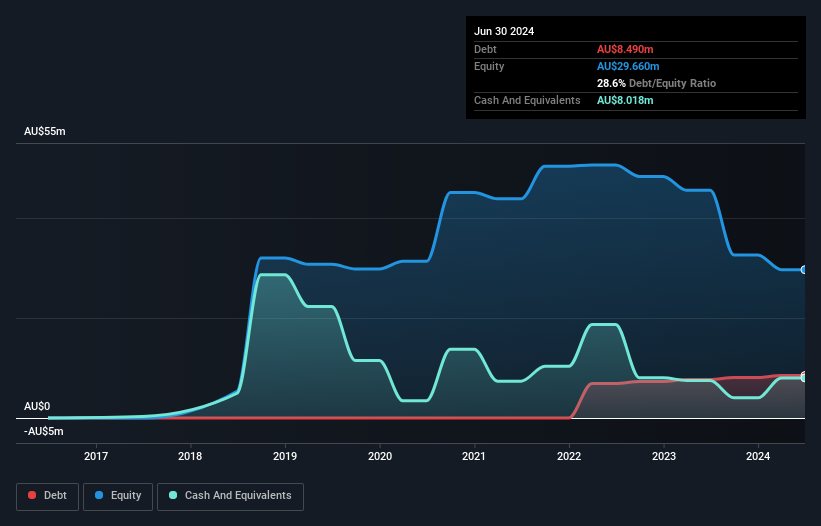
Legendary fund manager Li Lu (who Charlie Munger backed) once said, 'The biggest investment risk is not the volatility of prices, but whether you will suffer a permanent loss of capital.' So it seems the smart money knows that debt - which is usually involved in bankruptcies - is a very important factor, when you assess how risky a company is. As with many other companies Vintage Energy Limited (ASX:VEN) makes use of debt. But the real question is whether this debt is making the company risky.
Why Does Debt Bring Risk?
Generally speaking, debt only becomes a real problem when a company can't easily pay it off, either by raising capital or with its own cash flow. Ultimately, if the company can't fulfill its legal obligations to repay debt, shareholders could walk away with nothing. However, a more common (but still painful) scenario is that it has to raise new equity capital at a low price, thus permanently diluting shareholders. By replacing dilution, though, debt can be an extremely good tool for businesses that need capital to invest in growth at high rates of return. The first thing to do when considering how much debt a business uses is to look at its cash and debt together.
View our latest analysis for Vintage Energy
What Is Vintage Energy's Net Debt?
The image below, which you can click on for greater detail, shows that at June 2024 Vintage Energy had debt of AU$8.49m, up from AU$7.70m in one year. However, it also had AU$8.02m in cash, and so its net debt is AU$472.4k.

How Healthy Is Vintage Energy's Balance Sheet?
The latest balance sheet data shows that Vintage Energy had liabilities of AU$3.60m due within a year, and liabilities of AU$19.8m falling due after that. Offsetting this, it had AU$8.02m in cash and AU$501.2k in receivables that were due within 12 months. So its liabilities total AU$14.8m more than the combination of its cash and short-term receivables.
This deficit is considerable relative to its market capitalization of AU$15.0m, so it does suggest shareholders should keep an eye on Vintage Energy's use of debt. This suggests shareholders would be heavily diluted if the company needed to shore up its balance sheet in a hurry. When analysing debt levels, the balance sheet is the obvious place to start. But it is future earnings, more than anything, that will determine Vintage Energy's ability to maintain a healthy balance sheet going forward. So if you want to see what the professionals think, you might find this free report on analyst profit forecasts to be interesting.
In the last year Vintage Energy wasn't profitable at an EBIT level, but managed to grow its revenue by 443%, to AU$5.2m. When it comes to revenue growth, that's like nailing the game winning 3-pointer!
Caveat Emptor
While we can certainly appreciate Vintage Energy's revenue growth, its earnings before interest and tax (EBIT) loss is not ideal. Its EBIT loss was a whopping AU$24m. Considering that alongside the liabilities mentioned above does not give us much confidence that company should be using so much debt. Quite frankly we think the balance sheet is far from match-fit, although it could be improved with time. However, it doesn't help that it burned through AU$6.6m of cash over the last year. So suffice it to say we consider the stock very risky. When analysing debt levels, the balance sheet is the obvious place to start. But ultimately, every company can contain risks that exist outside of the balance sheet. Be aware that Vintage Energy is showing 4 warning signs in our investment analysis , and 2 of those can't be ignored...
When all is said and done, sometimes its easier to focus on companies that don't even need debt. Readers can access a list of growth stocks with zero net debt 100% free, right now.
New: Manage All Your Stock Portfolios in One Place
We've created the ultimate portfolio companion for stock investors, and it's free.
• Connect an unlimited number of Portfolios and see your total in one currency
• Be alerted to new Warning Signs or Risks via email or mobile
• Track the Fair Value of your stocks
Have feedback on this article? Concerned about the content? Get in touch with us directly. Alternatively, email editorial-team (at) simplywallst.com.
This article by Simply Wall St is general in nature. We provide commentary based on historical data and analyst forecasts only using an unbiased methodology and our articles are not intended to be financial advice. It does not constitute a recommendation to buy or sell any stock, and does not take account of your objectives, or your financial situation. We aim to bring you long-term focused analysis driven by fundamental data. Note that our analysis may not factor in the latest price-sensitive company announcements or qualitative material. Simply Wall St has no position in any stocks mentioned.
About ASX:VEN
Vintage Energy
Acquires, explores for, and develops oil and gas properties in Australia.
High growth potential and good value.
Similar Companies
Market Insights
Community Narratives



